微人事项目笔记
服务端菜单接口设计
实体类设计
菜单menu
1
2
3
4
5
6
7
8
9
10
11
12
13
14
15
16
17
18
19
20
21
22
23
24
25
26
27
28
29
30
31
32
33
34
35
36
37
38
39
40
41
42
43
44
45
46
47
48
49
50
51
52
53
54
55
56
57
58
59
60
61
62
63
64
65
66
67
68
69
70
71
72
73
74
75
76
77
78
79
80
81
82
83
84
85
86
87
88
89
90
91
92
93
94
95
96
97
98
99
100
101
102
103
104
105
106
107
108
109
110
111
112
113
114package com.lcdzzz.demo.model;
import java.io.Serializable;
import java.util.List;
public class Menu implements Serializable {
private Integer id;
private String url;
private String path;
private String component;
private String name;
private String iconCls;
private Meta meta;
private Integer parentId;
private Boolean enabled;
private List<Menu> children;
private List<Role> roles;
public List<Role> getRoles() {
return roles;
}
public void setRoles(List<Role> roles) {
this.roles = roles;
}
public Meta getMeta() {
return meta;
}
public void setMeta(Meta meta) {
this.meta = meta;
}
public List<Menu> getChildren() {
return children;
}
public void setChildren(List<Menu> children) {
this.children = children;
}
public Integer getId() {
return id;
}
public void setId(Integer id) {
this.id = id;
}
public String getUrl() {
return url;
}
public void setUrl(String url) {
this.url = url;
}
public String getPath() {
return path;
}
public void setPath(String path) {
this.path = path;
}
public String getComponent() {
return component;
}
public void setComponent(String component) {
this.component = component;
}
public String getName() {
return name;
}
public void setName(String name) {
this.name = name;
}
public String getIconCls() {
return iconCls;
}
public void setIconCls(String iconCls) {
this.iconCls = iconCls;
}
public Integer getParentId() {
return parentId;
}
public void setParentId(Integer parentId) {
this.parentId = parentId;
}
public Boolean getEnabled() {
return enabled;
}
public void setEnabled(Boolean enabled) {
this.enabled = enabled;
}
}虽然menu表中有keepAlive和requiredAuth字段,但是一般这种“额外的数据”,会额外地放在一个meta实体类中
1
2
3
4
5
6
7
8
9
10
11
12
13
14
15
16
17
18
19
20
21
22
23
24package com.lcdzzz.demo.model;
public class Meta {
private Boolean keepAlive;
private Boolean requireAuth;
public Boolean getKeepAlive() {
return keepAlive;
}
public void setKeepAlive(Boolean keepAlive) {
this.keepAlive = keepAlive;
}
public Boolean getRequireAuth() {
return requireAuth;
}
public void setRequireAuth(Boolean requireAuth) {
this.requireAuth = requireAuth;
}
}
创建一个controller去查询所需要的数据,SystemConfigController
1
2
3
4
5
6
7
8
9
10
11
public class SystemConfigController {
MenuService menuService;
public List<Menu> getMenusByHrId(){
return menuService.getMenusByHrId();
}
}Service类,MenuService,先得到当前登录的用户对象,然后通过getId()来得到id值
1
2
3
4
5
6
7
8
9
10
11
12
public class MenuService {
MenuMapper menuMapper;
public List<Menu> getMenusByHrId() {
return menuMapper.getMenusByHrId(((Hr) SecurityContextHolder.getContext().getAuthentication().getPrincipal()).getId());
/*这个Principal就是这个当前登录的用户对象*/
}
}所以MenuMapper接口中会有这么一个方法定义
1
List<Menu> getMenusByHrId(Integer hrid);
对应的xml文件里的sql语句
1
2
3
4
5
6
7
8
9
10
11
12
13
14
15
16
17
18
19<select id="getMenusByHrId" resultMap="Menus2">
select distinct m1.*,
m2.`id` as id2,
m2.`component` as component2,
m2.`enabled` as enabled2,
m2.`iconCls` as iconCls2,
m2.`keepAlive` as keepAlive2,
m2.`name` as name2,
m2.`parentId` as parentId2,
m2.`requireAuth` as requireAuth2,
m2.`path` as path2
from menu m1,menu m2,hr_role hrr,menu_role mr
where m1.`id`=m2.`parentId`
and hrr.`hrid`=#{hrid}
and hrr.`rid`=mr.`rid`
and mr.`mid`=m2.`id`
and m2.`enabled`=1
order by m1.`id`,m2.`id`
</select>里面用到的resultMap有
1
2
3
4
5
6
7
8
9
10
11
12
13
14
15
16
17
18
19
20
21
22
23
24
25
26
27
28
29
30
31
32<resultMap id="Menus2" type="com.lcdzzz.demo.model.Menu" extends="BaseResultMap">
<collection property="children" ofType="com.lcdzzz.demo.model.Menu">
<id column="id2" property="id" jdbcType="INTEGER" />
<result column="url2" property="url" jdbcType="VARCHAR" />
<result column="path2" property="path" jdbcType="VARCHAR" />
<result column="component2" property="component" jdbcType="VARCHAR" />
<result column="name2" property="name" jdbcType="VARCHAR" />
<result column="iconCls2" property="iconCls" jdbcType="VARCHAR" />
<result column="parentId2" property="parentId" jdbcType="INTEGER" />
<result column="enabled2" property="enabled" jdbcType="BIT" />
<association property="meta" javaType="com.lcdzzz.demo.model.Meta">
<result column="keepAlive2" property="keepAlive" jdbcType="BIT" />
<result column="requireAuth2" property="requireAuth" jdbcType="BIT" />
</association>
</collection>
</resultMap>
<resultMap id="BaseResultMap" type="com.lcdzzz.demo.model.Menu">
<id column="id" jdbcType="INTEGER" property="id"/>
<result column="url" jdbcType="VARCHAR" property="url"/>
<result column="path" jdbcType="VARCHAR" property="path"/>
<result column="component" jdbcType="VARCHAR" property="component"/>
<result column="name" jdbcType="VARCHAR" property="name"/>
<result column="iconCls" jdbcType="VARCHAR" property="iconCls"/>
<result column="parentId" jdbcType="INTEGER" property="parentId"/>
<result column="enabled" jdbcType="BIT" property="enabled"/>
<association property="meta" javaType="com.lcdzzz.demo.model.Meta">
<result column="keepAlive" jdbcType="BIT" property="keepAlive"/>
<result column="requireAuth" jdbcType="BIT" property="requireAuth"/>
</association>
</resultMap>
测试
- 登录
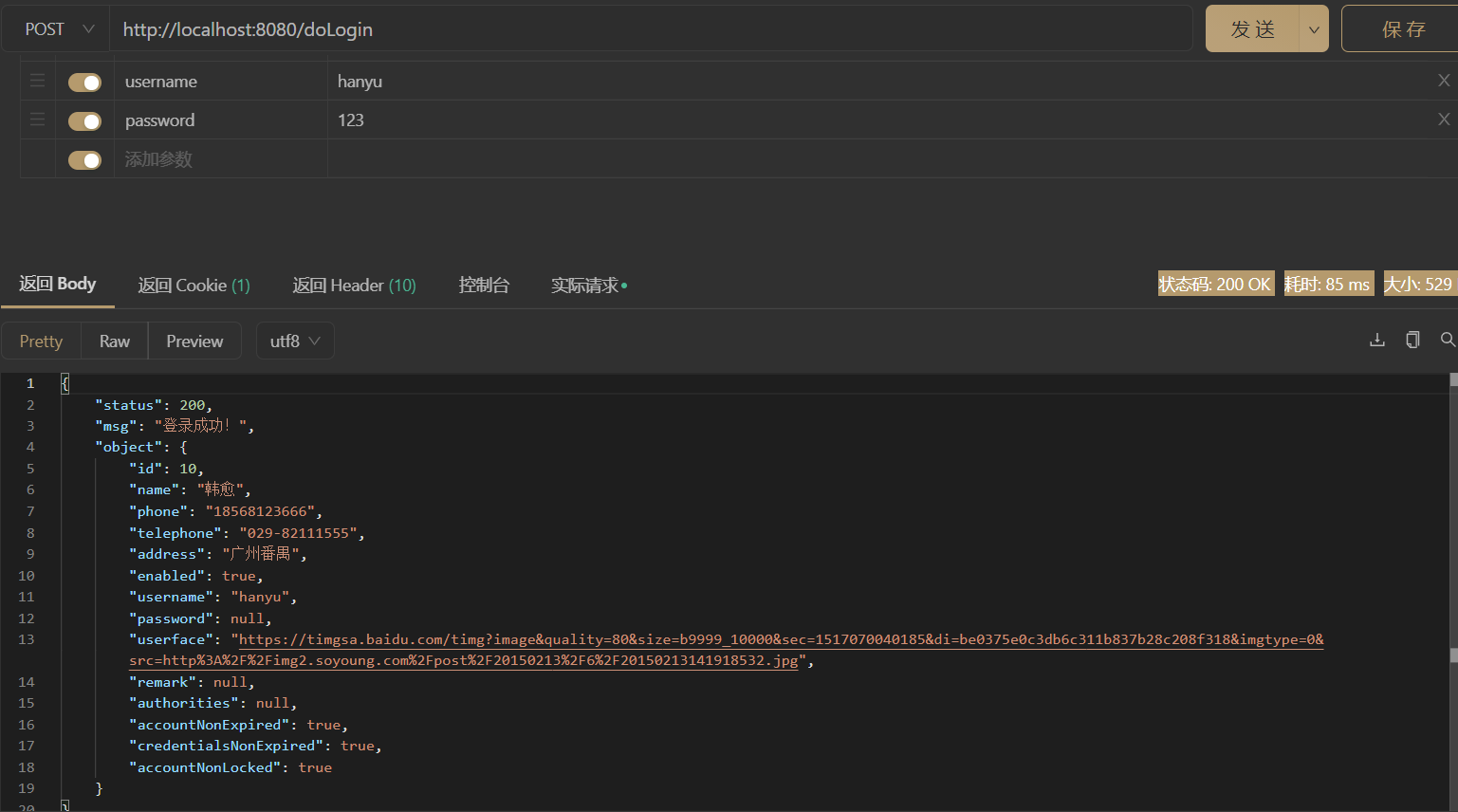
- 菜单
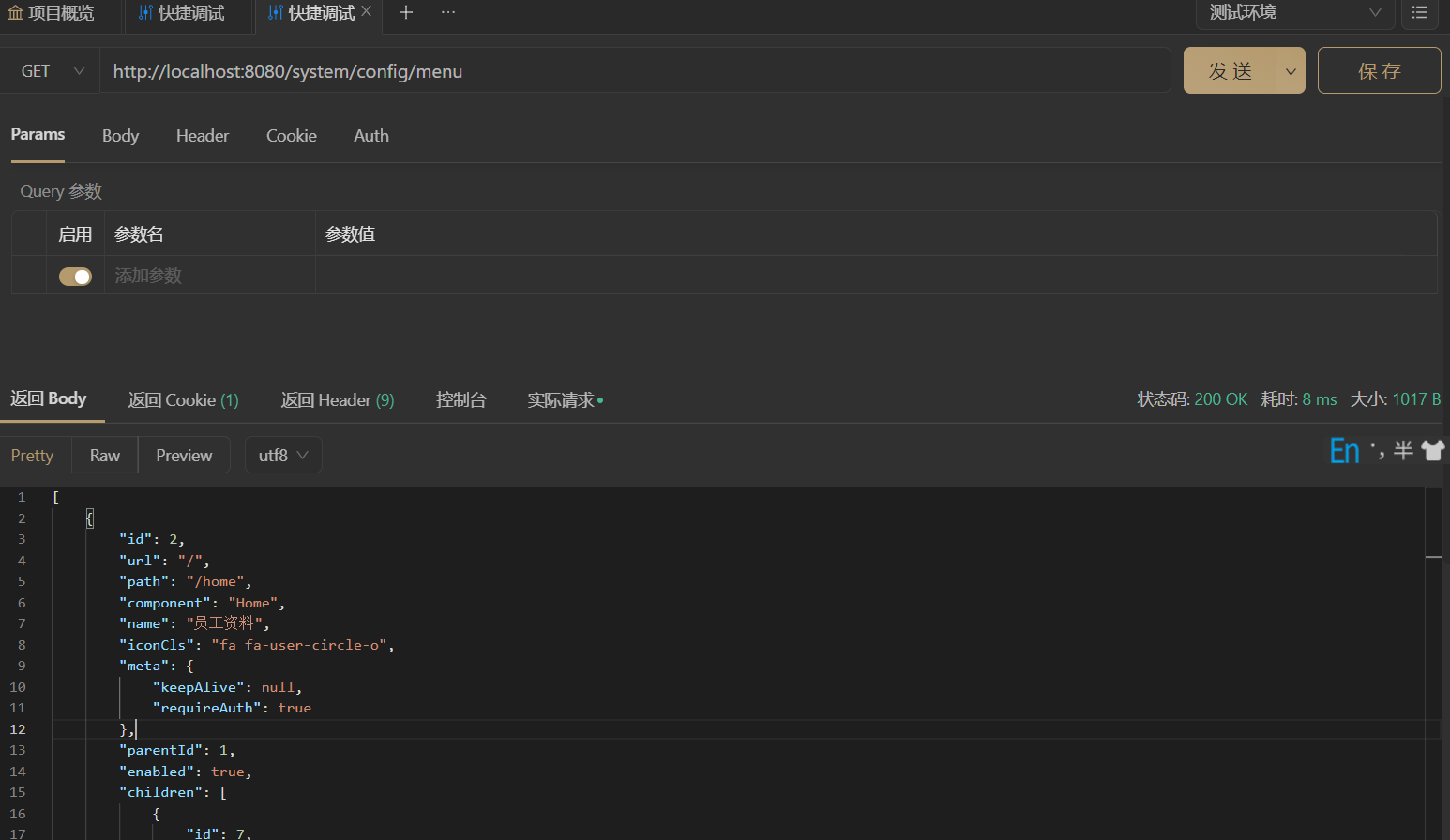
后端接口权限设计
注:目前项目不需要用到,暂不学习
整体的判断过程
根据用户发送过来的url地址提取出来它需要的角色判断当前用户是否具备相应的角色
代码实现
根据用户发送过来的url地址提取出来它需要的角色实体类Menu,添加一个这个属性private List<Role> roles; //意思是这个菜单项需要哪些角色才可以访问意思是这个菜单项需要哪些角色才可以访问
职位管理后端接口设计
实体类
1
2
3
4
5
6
7
8
9
10
11
12
13
14
15
16
17
18
19
20
21
22
23
24
25
26
27
28
29
30
31
32
33
34
35
36
37
38
39
40
41
42
43
44
45
46
47
48
49
50
51
52
53
54
55
56
57
58
59public class Position implements Serializable {
private Integer id;
private String name;
private Date createDate;
private Boolean enabled;
private static final long serialVersionUID = 1L;
public Integer getId() {
return id;
}
public void setId(Integer id) {
this.id = id;
}
public String getName() {
return name;
}
public void setName(String name) {
this.name = name;
}
public Date getCreateDate() {
return createDate;
}
public void setCreateDate(Date createDate) {
this.createDate = createDate;
}
public Boolean getEnabled() {
return enabled;
}
public void setEnabled(Boolean enabled) {
this.enabled = enabled;
}
public String toString() {
StringBuilder sb = new StringBuilder();
sb.append(getClass().getSimpleName());
sb.append(" [");
sb.append("Hash = ").append(hashCode());
sb.append(", id=").append(id);
sb.append(", name=").append(name);
sb.append(", createDate=").append(createDate);
sb.append(", enabled=").append(enabled);
sb.append(", serialVersionUID=").append(serialVersionUID);
sb.append("]");
return sb.toString();
}controller.system.basic.PositionController(查询,添加,更新,删除)
1
2
3
4
5
6
7
8
9
10
11
12
13
14
15
16
17
18
19
20
21
22
23
24
25
26
27
28
29
30
31
32
33
34
35
36
public class PositionController {//职位管理
PositionService positionService;
//查询接口
public List<Position> getAllPosition(){
return positionService.getAllPosition();
}
public RespBean addPosition( Position position){//@RequestBody主要用来接收前端传递给后端的json字符串中的数据的(请求体中的数据的);
if (positionService.addPosition(position)==1){
return RespBean.ok("添加成功!");
}
return RespBean.error("添加失败!");
}
public RespBean updatePosition( Position position){
if (positionService.updatePosition(position)==1){
return RespBean.ok("更新成功!");
}
return RespBean.error("更新失败!");
}
public RespBean deletePositionById( Integer id){
if (positionService.deletePositionById(id)==1){
return RespBean.ok("删除成功!");
}
return RespBean.error("删除失败!");
}
}与之对应的service层下的
1
2
3
4
5
6
7
8
9
10
11
12
13
14
15
16
17
18
19
20
21
22
23
public class PositionService {
PositionMapper positionMapper;
public List<Position> getAllPosition() {
return positionMapper.getAllPosition();//查询
}
public Integer addPosition(Position position) {
position.setEnabled(true);
position.setCreateDate(new Date());
return positionMapper.insert(position);//添加
}
public Integer updatePosition(Position position) {
return positionMapper.updateByPrimaryKeySelective(position);//更新
}
public Integer deletePositionById(Integer id) {
return positionMapper.deleteByPrimaryKey(id);//删除
}
}对应的mapper层下的PositionMapper接口
1
2
3
4
5
6
7
8
9
10
11
12
13
14
15
public interface PositionMapper {
int deleteByPrimaryKey(Integer id);
int insert(Position record);
Position selectByPrimaryKey(Integer id);
List<Position> selectAll();
int updateByPrimaryKey(Position record);
int updateByPrimaryKeySelective(Position record);
List<Position> getAllPosition();
}PositionMapper.xml下的代码大多数是可以mybatis逆向工程自动生成的,这里写自动生成以外的和需要注意的sql语句,关于mybatis逆向工程可以参考https://www.cnblogs.com/youcoding/p/14693096.html 这篇博客。
1
2
3
4
5
6
7
8
9
10
11
12
13
14
15
16
17
18
19
20<select id="getAllPosition" resultMap="BaseResultMap">
select * from position
</select>
<!--这个较之普通的updateByPrimaryKey语句,区别在于这个sql语句不需要所有字段都有,如果一个字段没有值,则默认为null-->
<update id="updateByPrimaryKeySelective" parameterType="com.lcdzzz.model.Position" >
update position
<set >
<if test="name != null" >
name = #{name,jdbcType=VARCHAR},
</if>
<if test="createDate != null" >
createDate = #{createDate,jdbcType=TIMESTAMP},
</if>
<if test="enabled != null" >
enabled = #{enabled,jdbcType=BIT},
</if>
</set>
where id = #{id,jdbcType=INTEGER}
</update>测试
登录不演示,和服务端菜单接口设计的登录是一样的
查询接口 http://localhost:8080/system/basic/pos/ 【get】
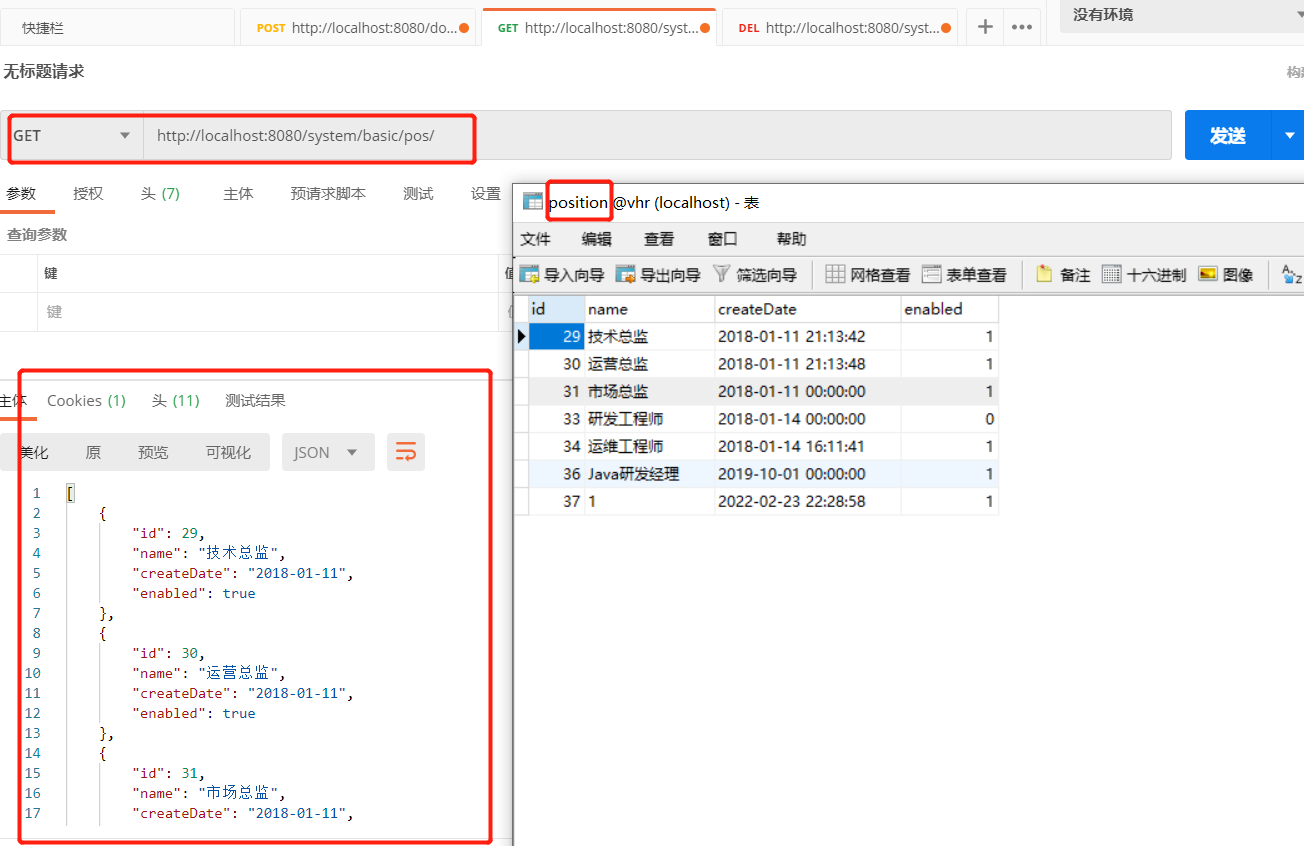
- 添加接口 http://localhost:8080/system/basic/pos/ 【post】
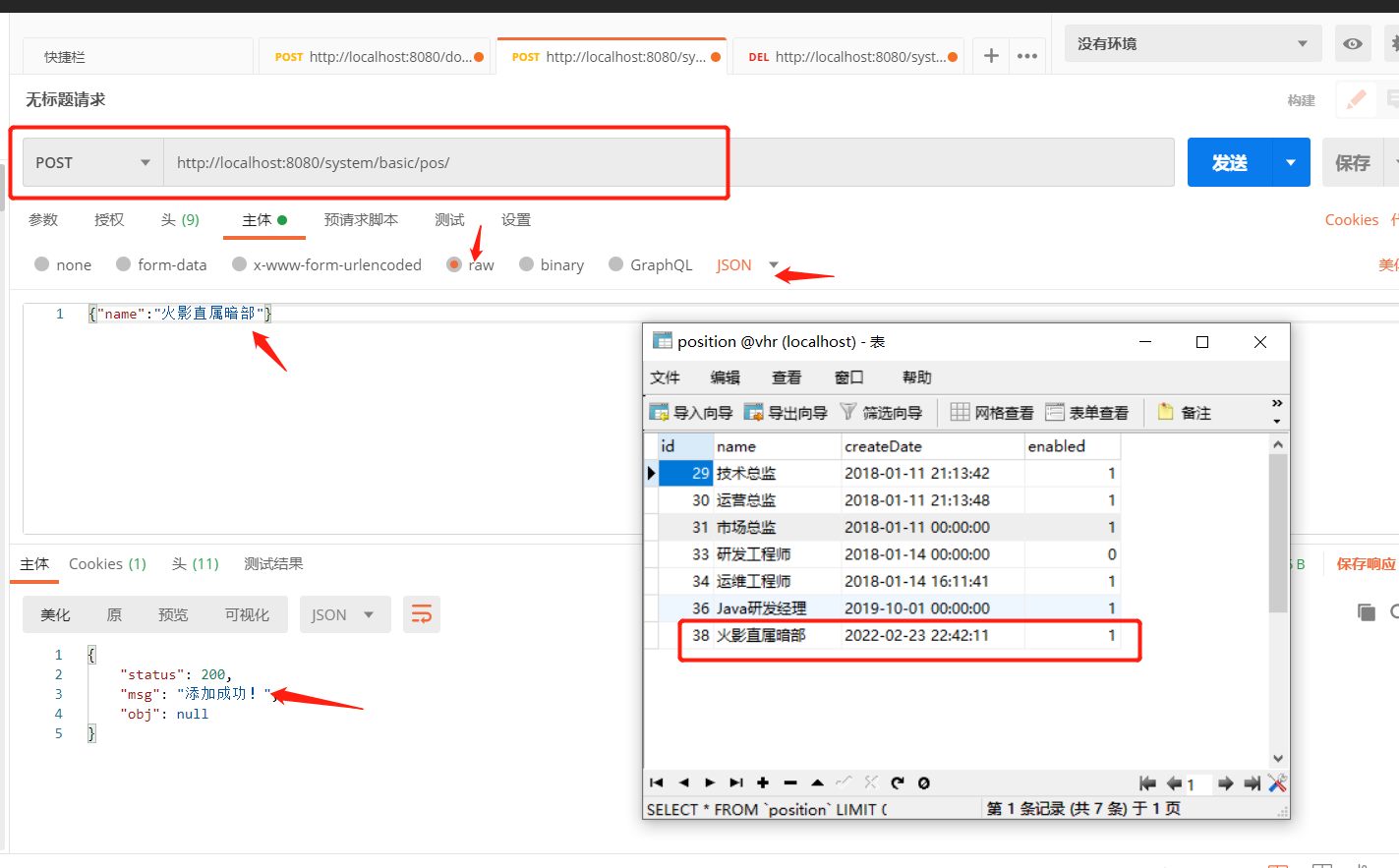
- 更新接口 http://localhost:8080/system/basic/pos/ 【put】
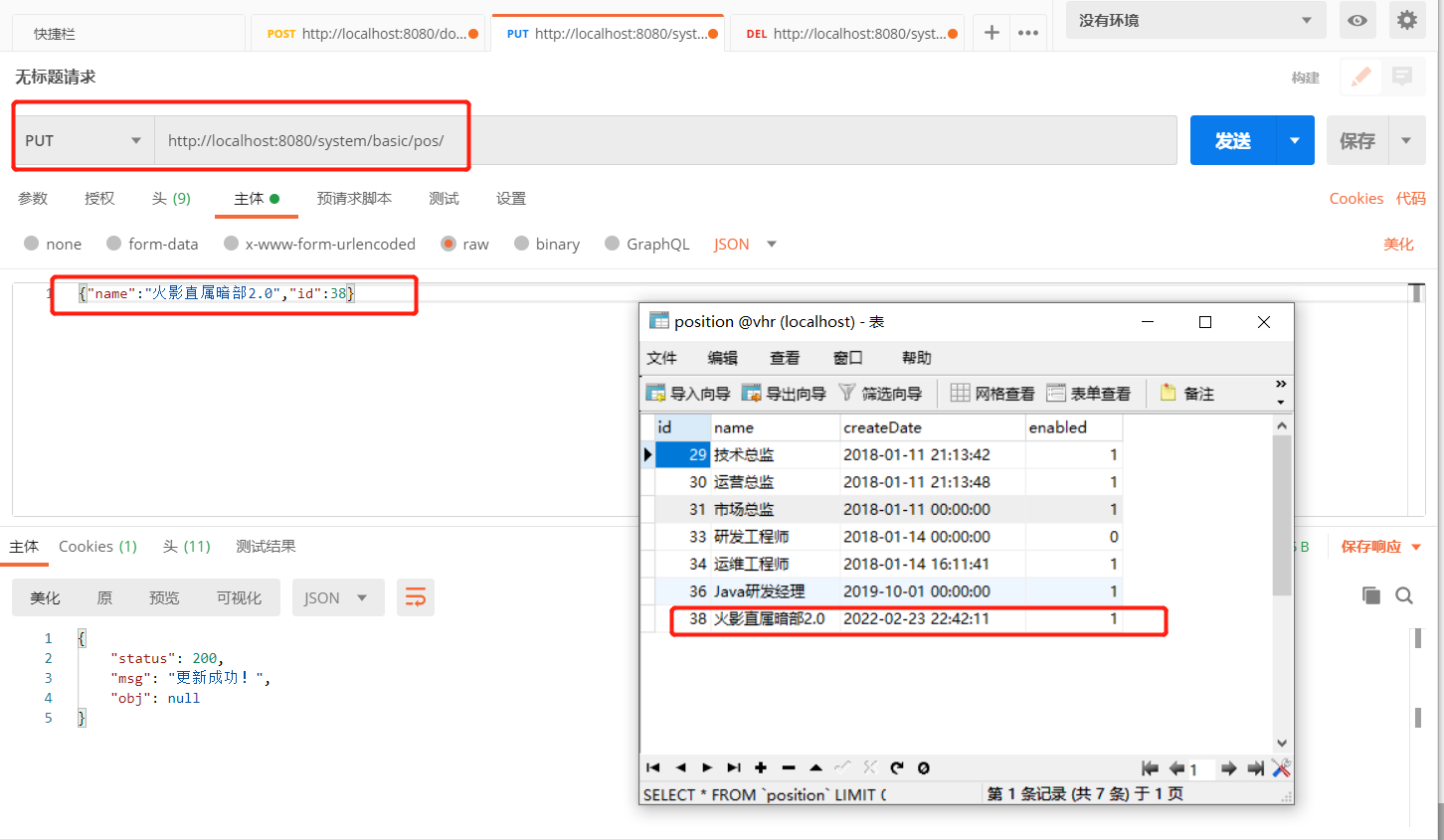
- 删除接口 http://localhost:8080/system/basic/pos/38 【delete】

批量删除
Controller层
1
2
3
4
5
6
7
8
public RespBean deletePositionByIds( Integer[] ids){
if (positionService.deletePositionByIds(ids)==ids.length){
return RespBean.ok("删除成功!");
}
return RespBean.ok("删除失败!");
}service层
1
2
3public Integer deletePositionByIds(Integer[] ids) {
return positionMapper.deletePositionByIds(ids);
}mapper接口
1
Integer deletePositionByIds( Integer[] ids);
xml文件
1
2
3
4
5
6<delete id="deletePositionByIds">
delete from position where id in
<foreach collection="ids" item="id" separator="," open="(" close=")">
#{id}
</foreach>
</delete>测试
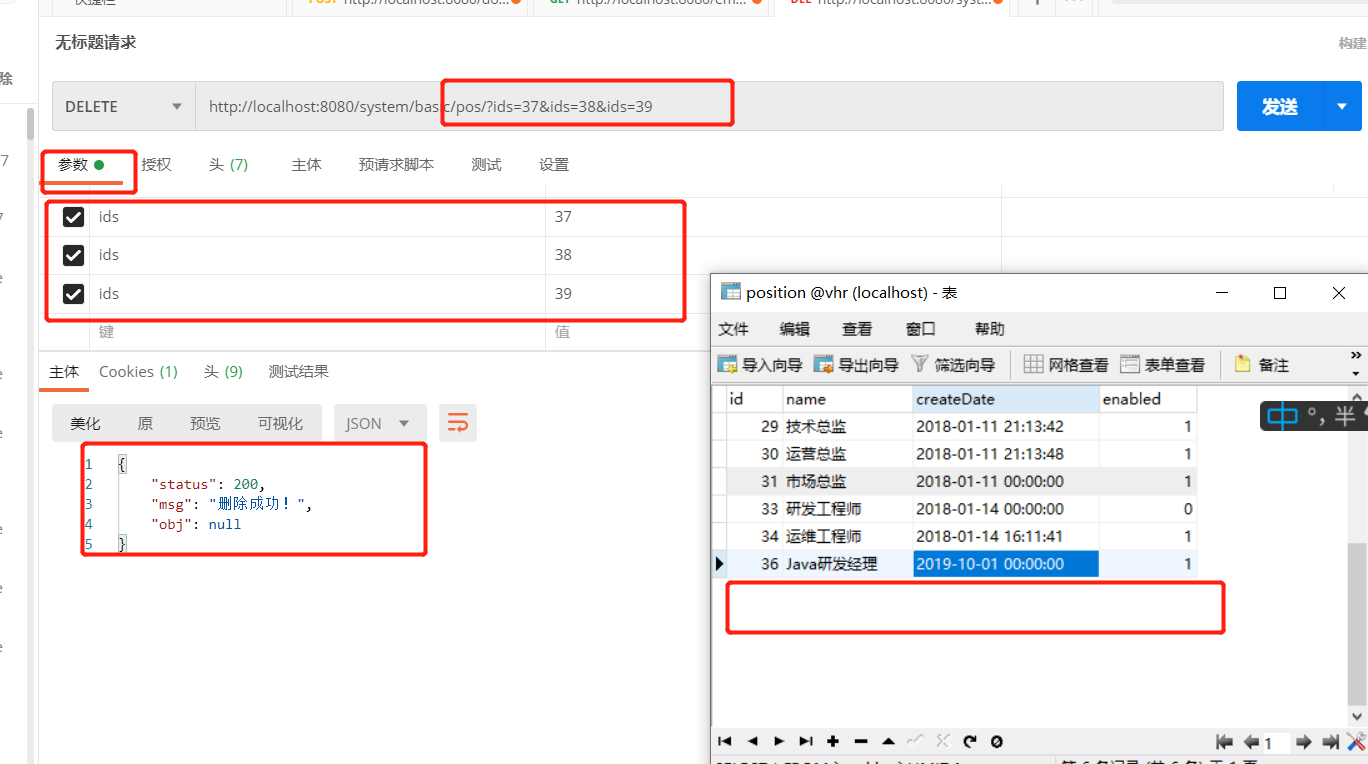
员工管理
数据分页及搜索
实体类,为了节省篇幅,getset方法就不放上去了(实际上有)
1
2
3
4
5
6
7
8
9
10
11
12
13
14
15
16
17
18
19
20
21
22
23
24
25
26
27
28
29
30
31
32
33
34
35
36
37
38
39
40
41
42
43
44
45
46
47
48
49
50
51
52
53
54
55
56
57
58
59
60
61
62
63
public class Employee implements Serializable {
private Integer id;
private String name;
private String gender;
private Date birthday;
private String idCard;
private String wedlock;
private Integer nationId;
private String nativePlace;
private Integer politicId;
private String email;
private String phone;
private String address;
private Integer departmentId;
private Integer jobLevelId;
private Integer posId;
private String engageForm;
private String tiptopDegree;
private String specialty;
private String school;
private Date beginDate;
private String workState;
private String workID;
private Double contractTerm;
private Date conversionTime;
private Date notWorkDate;
private Date beginContract;
private Date endContract;
private Integer workAge;
private Nation nation;
private Politicsstatus politicsstatus;
private Department department;
private JobLevel jobLevel;
private Position position;controller层
1
2
3
4
5
6
7
8
9
10
11
12
public class EmpBasicController {
EmployeeService employeeService;
public RespPageBean getEmployeeByPage( Integer page,
/*默认查询第一页,每页查询10个*/ Integer size
,String keyword){
return employeeService.getEmployeeByPage(page,size,keyword);
}
}service层
1
2
3
4
5
6
7
8
9
10
11
12
13
14
15
16
public class EmployeeService {
EmployeeMapper employeeMapper;
public RespPageBean getEmployeeByPage(Integer page, Integer size, String keyword) {
if (page != null && size != null) {
page = (page - 1) * size;
}
List<Employee> data =employeeMapper.getEmployeeByPage(page,size,keyword);
Long total = employeeMapper.getTotal(keyword);
RespPageBean bean = new RespPageBean();
bean.setData(data);
bean.setTotal(total);
return bean;
}
}mapper接口
1
2
3
4
5
6
7
8
9
10
11
12
13
14
15public interface EmployeeMapper {
int deleteByPrimaryKey(Integer id);
int insert(Employee record);
Employee selectByPrimaryKey(Integer id);
List<Employee> selectAll();
int updateByPrimaryKey(Employee record);
List<Employee> getEmployeeByPage(@Param("page") Integer page, @Param("size") Integer size,@Param("keyword") String keyword);
Long getTotal(String keyword);
}xml的sql语句
1
2
3
4
5
6
7
8
9
10
11
12
13
14
15
16<select id="getEmployeeByPage" resultMap="AllEmployeeInfo">
select e.*,p.`id` as pid,p.`name` as pname,n.`id` as nid,n.`name` as nname,d.`id` as did,d.`name` as
dname,j.`id` as jid,j.`name` as jname,pos.`id` as posid,pos.`name` as posname from employee e,nation
n,politicsstatus p,department d,joblevel j,position pos where e.`nationId`=n.`id` and e.`politicId`=p.`id` and
e.`departmentId`=d.`id` and e.`jobLevelId`=j.`id` and e.`posId`=pos.`id`
<if test="keyword !=null and keyword!=''">
and e.name like concat('%',#{keyword},'%')
</if>
limit #{page},#{size}
</select>
<select id="getTotal" resultType="java.lang.Long">
select count(*) from employee
<if test="keyword !=null and keyword!=''">
where name like concat('%',#{keyword},'%')
</if>;
</select>xml的resultMap定义
1
2
3
4
5
6
7
8
9
10
11
12
13
14
15
16
17
18
19
20
21
22<resultMap id="AllEmployeeInfo" type="com.lcdzzz.model.Employee" extends="BaseResultMap">
<association property="nation" javaType="com.lcdzzz.model.Nation">
<id column="nid" property="id"/>
<result column="nname" property="name"/>
</association>
<association property="politicsstatus" javaType="com.lcdzzz.model.Politicsstatus">
<id column="pid" property="id"/>
<result column="pname" property="name"/>
</association>
<association property="department" javaType="com.lcdzzz.model.Department">
<id column="did" property="id"/>
<result column="dname" property="name"/>
</association>
<association property="jobLevel" javaType="com.lcdzzz.model.JobLevel">
<id column="jid" property="id"/>
<result column="jname" property="name"/>
</association>
<association property="position" javaType="com.lcdzzz.model.Position">
<id column="posid" property="id"/>
<result column="posname" property="name"/>
</association>
</resultMap>分页测试
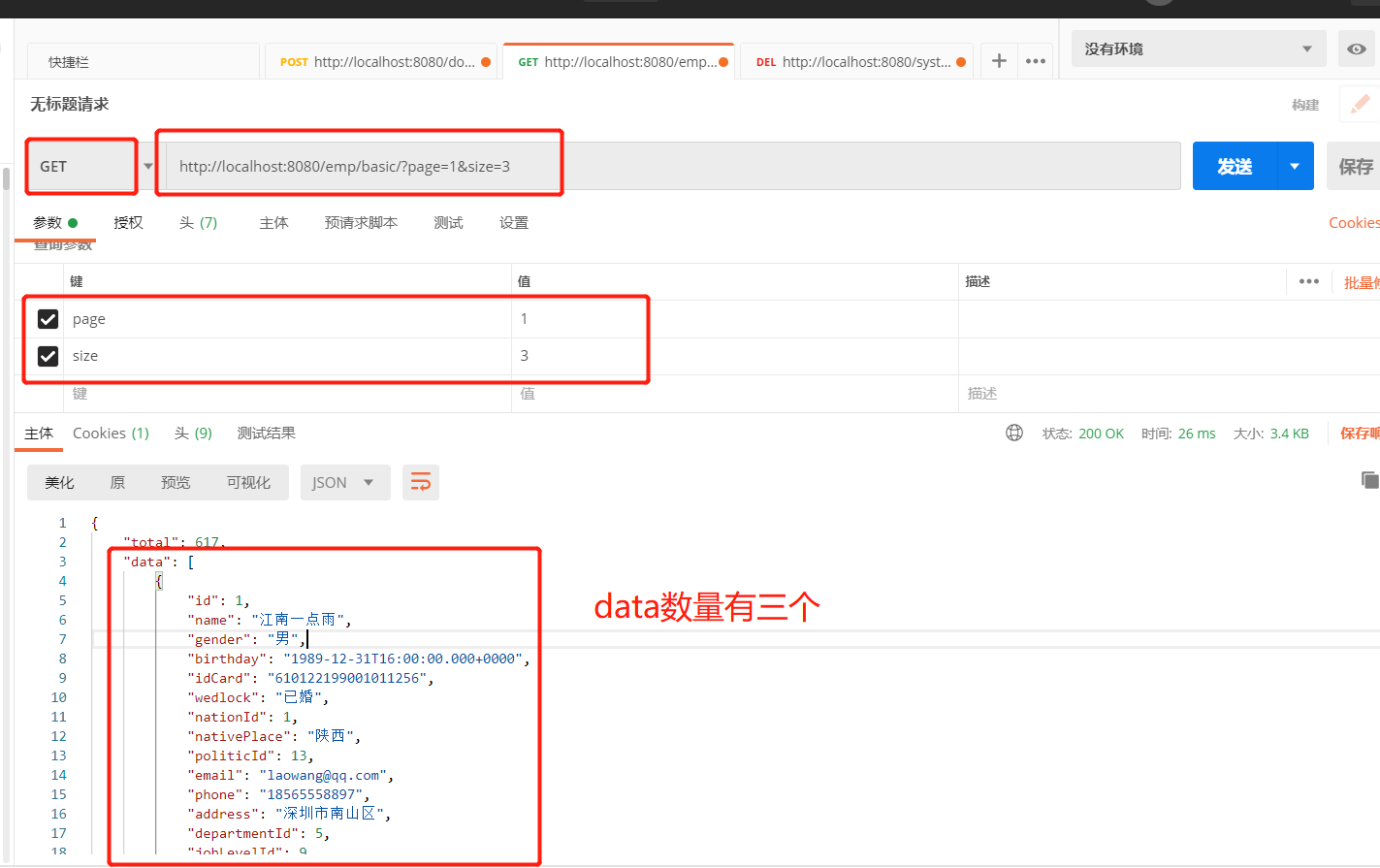
- 搜索+分页测试
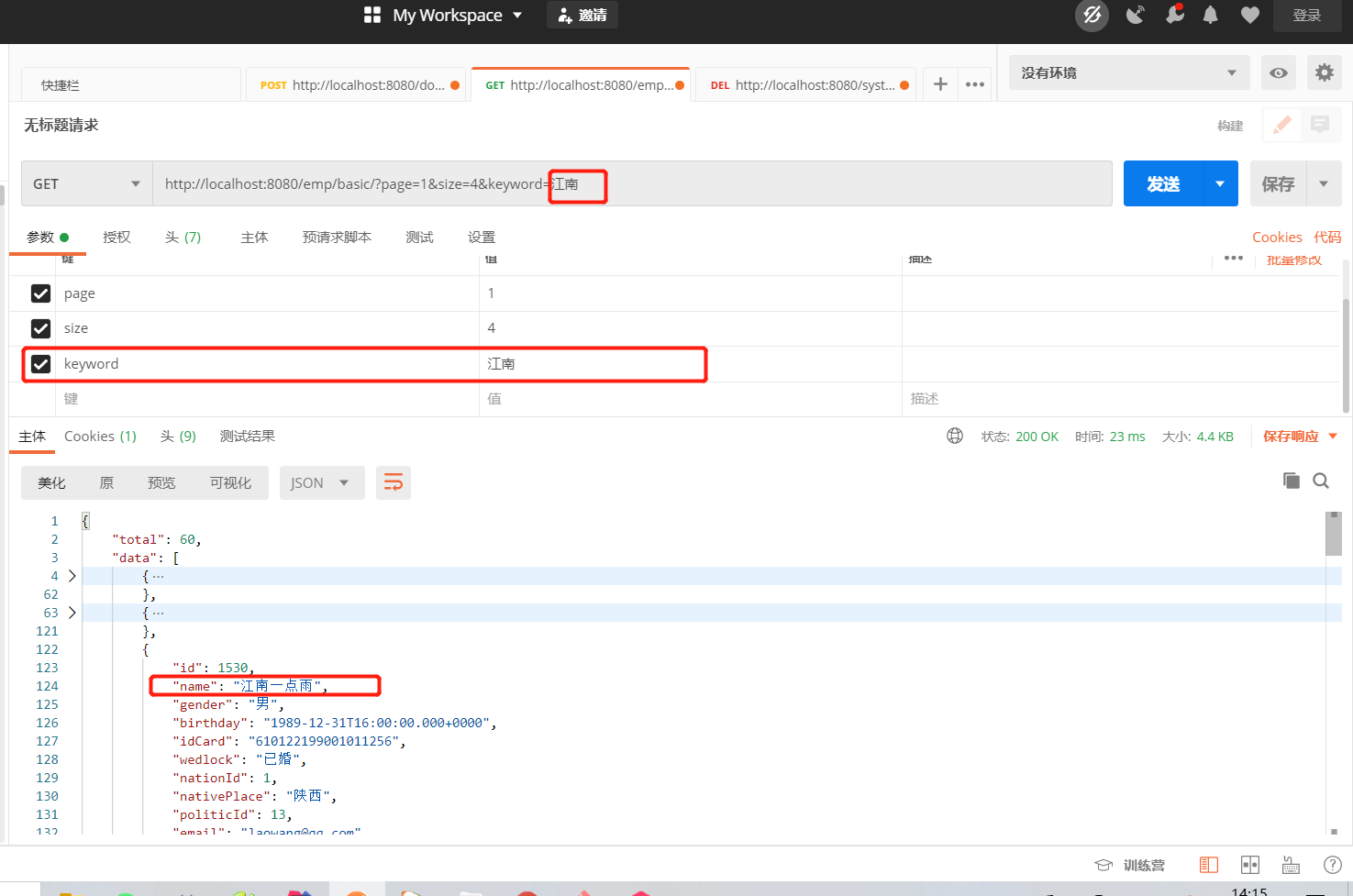
搭建邮件服务以及消息中间件
本博客所有文章除特别声明外,均采用 CC BY-NC-SA 4.0 许可协议。转载请注明来源 布鲁成周勒的博客!
评论










